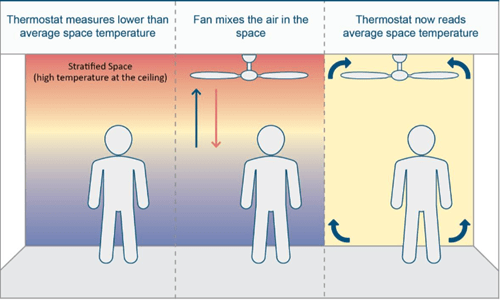
.png?h=168&w=500&hash=590A7EFF65539ACFCD22B367AC4C8FEB)
Got a Big Space to Heat? Increase Efficiency, Save Money Using HVLS Fans
Many of our products are used throughout HVAC systems globally, including our innovative Blade Runner™ direct-drive motor series that powers many brands of high-volume, low speed fans (“HVLS”). Working in an industrial setting, service shop, or warehouse, operations managers know that HVLS are a necessity – especially in the burning hot summer months.
As we are coming up on typical winter months, do not turn off the industrial fans! HVAC experts recommend running them clockwise at low speed. If clockwise is unavailable in the system, it is recommended that fans are run as normal at the lowest speed.
Keeping HVLS fans on in colder weather may seem counterintuitive, however, they can be an integral part of a HVAC system for energy efficient winter heating.
Destratification

Image courtesy of https://escholarship.org/uc/item/6s44510d
Destratification refers to the process of mixing layers of air together to prevent stratified layers of heat. Did you know that there can be more than a 20-degree (F) difference between the floor and ceiling in most manufacturing plants as a result of air destratification?
The team at Envira-North, one of our OEM partners,
gives a bit more insight to how keeping industrial fans on through the winter is beneficial. Envira-North’s HVLS fans are designed to maintain slow speeds while creating a high volume of air movement with little draft. By mixing the air and recirculating the warm air migrated at the ceiling, occupants will immediately feel the effects of the fan. Envira-North also notes that the equalization of temperature will help reduce the need for heating systems to be engaged, saving on wear/tear and operating costs associated with the utilization of those systems.
Savings
The amount of sheer natural gas costs alone may be saved by utilizing HVLS fans within industrial facilities is astronomical. In fact, HLVS fans have a saving range of
12 to 50 percent in cooling and heating costs. Did you know that some local energy providers even offer incentives for energy efficiency to utilize HVLS fans in industrial workspaces?
Climate Control
Condensation
Sweating Slab Syndrome refers to moisture intermittently developing on the surface of an interior industrial warehouse concrete slab.
The moisture (condensation) is prevented/remedied by keeping temperatures in the air and at the floor more evenly distributed, preventing the “sweat” that forms when warm air meets a cooler floor. The importance of preventing this moisture buildup is two-fold. Firstly, moisture on concrete or other hard surface floors is a safety hazard for employees. Secondly, circulated air prevents sweat beads and moisture from developing which, if uncontrolled, may lead to costly maintenance on machinery in manufacturing facilities. Condensation is the culprit behind premature rusting, especially on machines and equipment containing parts made from iron.
As part of the world’s most comprehensive manufacturer of electric motors, Nidec Motion Control has proven expertise in producing reliable and efficient direct-drive motors for our OEM partners who specialize in the design and manufacture of HVLS fans. Our OEM partners, in turn, can provide a comprehensive solution for their customers’ HVAC systems, driving down operating costs and improving working environments. For Nidec Motion Control, it is gratifying to be a part of that solution and to share the many benefits of HVLS fans.

.png?h=168&w=500&hash=590A7EFF65539ACFCD22B367AC4C8FEB)


